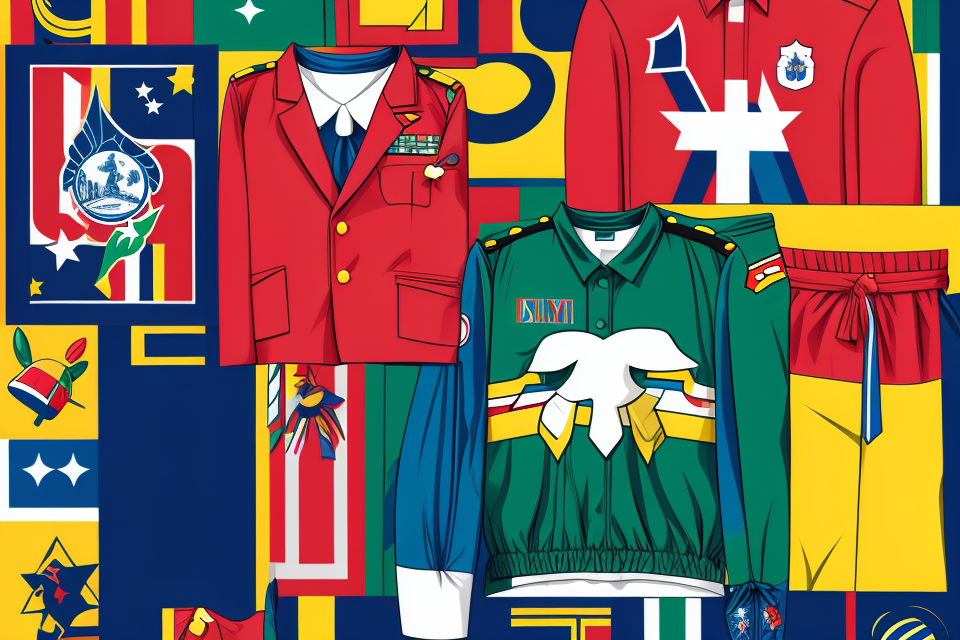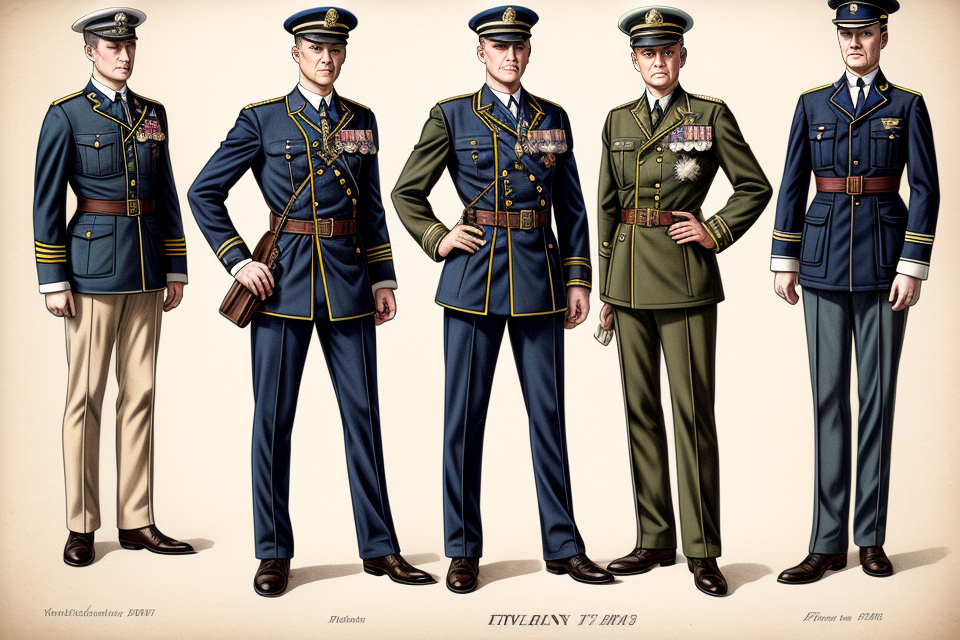
A uniform is a set of standardized clothing worn by individuals in a particular organization or group. It is often associated with authority, power, and identity. But what does a uniform symbolize beyond its practical purpose? This topic delves into the deeper meaning behind the clothes we wear and how they reflect our values, beliefs, and history. Join us as we explore the symbolism of uniforms and how they shape our perception of the world around us.
A uniform symbolizes a sense of unity and belonging to a group or organization. It is a standardized set of clothing worn by individuals who are part of a particular institution, company, or military force. The uniform represents a shared identity and purpose, and it helps to create a sense of pride and loyalty among those who wear it. Additionally, uniforms often serve as a means of identification, allowing others to quickly recognize a person’s affiliation or role within an organization. Overall, the uniform is a powerful symbol that helps to foster a sense of community and belonging among those who wear it.
The significance of uniforms in various contexts
Military uniforms
History and evolution of military uniforms
The use of uniforms in the military dates back to ancient times, where warriors would wear distinctive clothing to identify themselves as members of a particular group or unit. Over time, military uniforms have evolved to serve not only as a means of identification but also as a symbol of unity, discipline, and authority.
Impact on morale and identity
Military uniforms play a crucial role in fostering a sense of belonging and identity among service members. They help to create a shared sense of purpose and promote esprit de corps, which is essential for the cohesion and effectiveness of military units. Moreover, wearing a uniform can enhance morale by creating a sense of pride and professionalism among service members.
Influence on recruitment and retention
Uniforms can also have a significant impact on recruitment and retention in the military. A well-designed uniform can attract potential recruits by conveying a sense of professionalism and discipline. Moreover, wearing a uniform can increase job satisfaction and pride among service members, which can lead to higher retention rates.
Uniforms in modern warfare
Standardization and recognition
In modern warfare, standardized uniforms are essential for maintaining discipline and unity within the ranks. Uniforms help to establish a clear chain of command and ensure that all service members understand their roles and responsibilities. Moreover, standardized uniforms can help to improve recognition and identification of friendly forces, which is critical in the chaos of battle.
Camouflage and concealment
Another important aspect of military uniforms is camouflage and concealment. Modern military uniforms are designed to blend in with the environment, making it more difficult for enemies to spot and target service members. This is particularly important in asymmetric warfare, where irregular forces often rely on hit-and-run tactics to evade and attack enemy forces.
In summary, military uniforms serve as a symbol of unity, discipline, and authority, while also providing practical benefits such as camouflage and recognition. The design and implementation of military uniforms can have a significant impact on morale, recruitment, and retention within the military, making them a critical component of modern warfare.
Police uniforms
History and evolution of police uniforms
The history of police uniforms dates back to the early 19th century when the first modern police force was established in London. Initially, police officers did not wear any distinctive uniforms and were dressed in civilian clothing. However, as the police force grew and became more professionalized, the need for a uniform became apparent.
The first police uniforms were designed to symbolize authority and differentiate police officers from civilians. The traditional police uniform consisted of a tunic, trousers, and a peaked cap. This design was inspired by the military uniforms of the time and was intended to convey a sense of discipline and order.
Over time, the design of police uniforms has evolved to reflect changes in society and technology. For example, the introduction of firearms and riot gear has led to the development of more practical and protective uniforms.
Symbolism and authority
The uniform worn by police officers serves as a symbol of authority and represents the state and its power to enforce the law. The uniform is designed to convey a sense of professionalism and discipline, which is intended to inspire respect and obedience from the public.
The uniform also serves as a visual reminder of the police officer’s role in maintaining law and order. The uniform is often a powerful tool for establishing trust and confidence in the police force, especially in times of crisis or emergency.
Community relations and trust
The uniform worn by police officers plays a crucial role in community relations and trust. A well-designed uniform can help to build trust between the police and the public by creating a sense of familiarity and authority.
However, the design of the uniform can also have a negative impact on community relations if it is perceived as intimidating or aggressive. For example, some police departments have faced criticism for using riot gear and military-style uniforms, which can be seen as escalating tensions between the police and the public.
In recent years, some police departments have experimented with new designs for their uniforms, incorporating more casual and approachable elements. These new designs are intended to create a more positive image of the police force and improve community relations.
Uniforms in contemporary law enforcement
Technology and functionality
Contemporary police uniforms are designed to incorporate the latest technology and functionality. For example, many police officers now wear body armor and tactical gear, which provides protection against physical threats and enables them to carry out their duties more effectively.
Police uniforms may also include equipment such as radios, handcuffs, and firearms, which are essential tools for law enforcement. The design of the uniform must take into account the practical needs of the police officer while still maintaining a professional and authoritative image.
Public perception and accountability
The design of police uniforms can have a significant impact on public perception and accountability. A well-designed uniform can help to establish trust and confidence in the police force, while a poorly designed uniform can erode public trust and create tensions between the police and the community.
In recent years, there has been growing concern about police accountability and the use of excessive force by police officers. The design of police uniforms can play a role in promoting accountability by creating a clear distinction between police officers and civilians, and by promoting a culture of professionalism and respect for human rights.
Overall, the design of police uniforms is a complex issue that must take into account a range of factors, including symbolism, functionality, and public perception. A well-designed uniform can help to promote trust and confidence in the police force, while a poorly designed uniform can create tensions and erode public trust.
School uniforms
History and purpose of school uniforms
School uniforms have been a longstanding tradition in many educational institutions, with their origins dating back to the 16th century in England. The primary purpose of school uniforms was to create a sense of tradition and discipline among students. It was believed that by wearing a uniform, students would feel a sense of belonging and responsibility towards their school, and this would encourage them to behave in a more orderly and respectful manner.
In addition to tradition and discipline, economic and social factors also played a role in the implementation of school uniforms. In many cases, school uniforms were a way for schools to promote a sense of equality among students, as all students wore the same clothing, regardless of their socioeconomic background. This helped to reduce the visibility of social class differences and created a more inclusive environment for all students.
Uniforms in contemporary education
Despite the longstanding tradition of school uniforms, their use in contemporary education is still a topic of debate and controversy. Some argue that school uniforms infringe on students’ right to express their individuality and self-expression, while others believe that they promote a sense of unity and belonging among students.
One study conducted in the United States found that school uniforms had a positive impact on student behavior and academic performance. The study found that students who wore uniforms were less likely to engage in disruptive behavior and were more likely to attend school regularly. Additionally, students who wore uniforms were found to have higher academic achievement scores compared to those who did not wear uniforms.
However, other studies have found that school uniforms have little to no impact on student behavior and academic performance. Critics argue that the focus should be on providing a supportive and inclusive learning environment, rather than on the clothes that students wear.
Overall, the use of school uniforms in contemporary education is a complex issue, with arguments both for and against their use. While some argue that they promote a sense of tradition, discipline, and unity, others argue that they infringe on students’ individuality and self-expression.
The psychology behind uniforms
Identification and belonging
Uniforms play a significant role in identifying individuals as members of a particular group. Wearing a uniform helps individuals feel a sense of belonging to the organization or institution they represent. This feeling of belonging is primarily due to the symbolic meaning that uniforms hold for the individuals wearing them.
In-group identification and loyalty
Wearing a uniform can create a sense of in-group identification and loyalty among individuals. When individuals wear the same uniform, they feel a sense of unity and shared identity with their fellow group members. This shared identity can foster a sense of belonging and loyalty towards the group, which can translate into increased motivation and commitment to the organization or institution.
Out-group differentiation and exclusion
Uniforms can also be used to differentiate between in-groups and out-groups. When individuals wear a uniform, they are easily identifiable as members of a particular group, which can lead to the exclusion of non-members. This differentiation and exclusion can create a sense of us-vs-them mentality, which can further strengthen the sense of belonging and loyalty towards the in-group.
Overall, the sense of identification and belonging that uniforms create can have a significant impact on the attitudes and behaviors of individuals who wear them.
Power dynamics and authority
Submission and obedience
A uniform can be seen as a symbol of submission and obedience. Wearing a uniform signifies that the individual is willing to conform to the rules and regulations set by the organization they represent. This can create a sense of unity and discipline within the group, as everyone is expected to adhere to the same standards. Additionally, wearing a uniform can also create a sense of belonging and identity for the individual, as they become part of a larger community with a shared purpose.
Dominance and control
On the other hand, a uniform can also symbolize dominance and control. The individual wearing the uniform represents the authority and power of the organization they represent. This can create a sense of respect and fear in others, as the uniformed individual is seen as someone who has the ability to enforce rules and consequences. Additionally, the uniform itself can be seen as a tool of control, as it restricts the individual’s personal expression and forces them to conform to a certain set of expectations.
The future of uniforms
Technological advancements
In recent years, technological advancements have revolutionized the world of uniforms, enabling them to serve new purposes and communicate important information. Here are some of the ways in which technology is transforming the role of uniforms:
Smart uniforms and wearable technology
Smart uniforms are clothing items that incorporate technology, such as sensors, microprocessors, and wireless connectivity, to monitor and transmit data about the wearer’s physical activity, vital signs, and other health metrics. This information can be used to optimize performance, prevent injuries, and improve overall well-being. Smart uniforms can also display real-time information, such as player statistics during a sports game, or alerts for emergency situations.
Material innovations and sustainability
Technological advancements are also driving innovations in the materials used to make uniforms. For example, new fabrics are being developed that are more breathable, moisture-wicking, and durable, allowing uniforms to perform better in different environments and conditions. Additionally, many companies are now using sustainable materials and production processes to reduce their environmental impact and promote eco-friendliness. Some uniforms are even designed to be biodegradable or made from recycled materials.
Cultural and societal shifts
In today’s rapidly changing world, uniforms are undergoing a transformation that reflects the cultural and societal shifts happening around us. Here are some of the key ways in which this is manifesting:
Diversity and inclusivity
As society becomes more diverse, the need for uniforms that cater to a wide range of individuals is becoming increasingly important. Many organizations are now moving away from traditional uniforms that are often designed to fit a narrow range of body types and skin tones. Instead, they are opting for more inclusive designs that are gender-neutral, size-inclusive, and reflective of different cultural backgrounds.
For example, some schools are now offering students the option to wear uniforms that reflect their cultural heritage, such as hijabs or kurtas. This not only promotes inclusivity but also helps students feel more proud of their cultural identity.
Workforce and organizational changes
As the nature of work changes, so too are the uniforms that employees wear. In many industries, the traditional suit and tie or business dress code is being replaced by more casual attire that is comfortable and functional. This reflects a shift towards a more relaxed work environment, where employees are valued for their skills and expertise rather than their appearance.
However, there are still many industries where traditional uniforms are required, such as healthcare, hospitality, and security. In these cases, uniforms are not just a symbol of professionalism but also a critical component of workplace safety and hygiene.
Overall, the future of uniforms is likely to be shaped by a desire for greater inclusivity, comfort, and functionality. As society continues to evolve, so too will the uniforms that we wear, reflecting our changing values and priorities.
Ethical considerations and challenges
Privacy and surveillance
In the future, uniforms may incorporate technology that can track an individual’s movements and monitor their behavior. While this can be useful for security purposes, it also raises concerns about privacy and surveillance. Employers and organizations must ensure that they are not violating their employees’ or members’ privacy rights by using such technology.
Human rights and labor laws
The use of uniforms can also raise issues related to human rights and labor laws. For example, some uniforms may be designed in a way that violates an individual’s religious or cultural beliefs. Employers must ensure that they are accommodating their employees’ beliefs and following relevant labor laws.
Stereotyping and discrimination
Uniforms can also perpetuate stereotypes and discrimination. For instance, certain uniforms may be associated with specific professions or social classes, which can lead to biases and prejudices. Employers and organizations must be aware of these potential biases and take steps to promote diversity and inclusion.
FAQs
1. What is a uniform?
A uniform is a set of standardized clothing worn by individuals in a particular organization, team, or profession to identify themselves and show their affiliation.
2. Why do people wear uniforms?
People wear uniforms to identify themselves as part of a group, to show their profession or occupation, to adhere to a dress code, or to maintain a level of discipline and order.
3. What does a uniform symbolize?
A uniform symbolizes the identity, role, and responsibilities of the individual wearing it. It represents the organization, team, or profession that the individual belongs to and signifies a sense of belonging, unity, and shared values. It also communicates a level of authority, professionalism, and trustworthiness.
4. What are the different types of uniforms?
There are many types of uniforms, including military uniforms, police uniforms, school uniforms, sports uniforms, healthcare uniforms, and work uniforms for various professions such as chefs, pilots, and security guards.
5. Why are uniforms important in the military?
Uniforms are important in the military because they help to establish a sense of order, discipline, and unity among soldiers. They also help to identify friend from foe in combat situations and promote a sense of belonging and camaraderie among military personnel.
6. Why do some organizations have strict dress codes?
Organizations may have strict dress codes to maintain a professional image, to ensure safety and functionality in the workplace, to prevent distractions, or to promote a culture of order and discipline. Dress codes may also reflect the values and identity of the organization.
7. Can you wear a uniform if you don’t agree with the values it represents?
In most cases, individuals are required to wear a uniform as part of their job or role in an organization, even if they don’t personally agree with the values or beliefs represented by the uniform. However, in some cases, individuals may be able to request an exemption from wearing a uniform for religious or other reasons.
8. What are the benefits of wearing a uniform?
Wearing a uniform can help to establish a sense of pride and belonging among individuals, promote a culture of discipline and order, and create a level of trust and credibility with the public. It can also make it easier for individuals to identify one another and establish a sense of hierarchy and authority.


